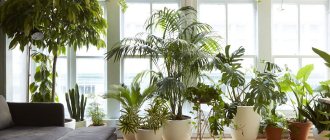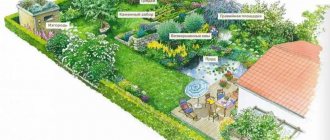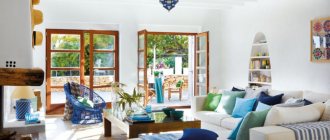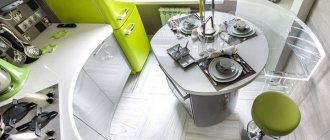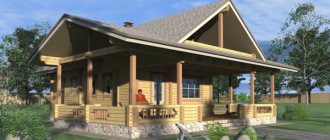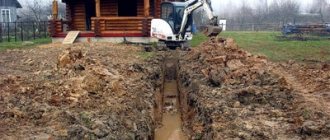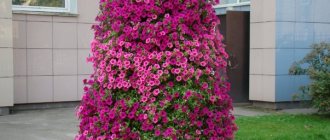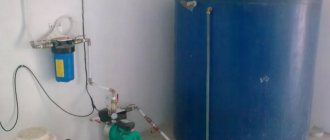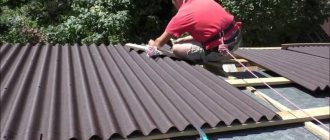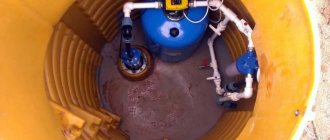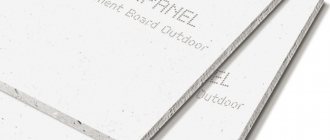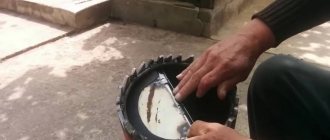A glass container with live plants and decorative elements looks unusual and stylish. Nowadays, all kinds of mini-florariums are in fashion, which can be easily placed on the coffee table, next to the computer. In small volumes, from 1 to 3 plants are used, less often 5 crops. Large florariums are often used to decorate offices or restaurants: huge display cases or aquariums with plants look very impressive. They can accommodate a large number of species, using them to create an imitation of a real tropical forest. But such ecosystems need to be specially regulated using temperature and humidity sensors. They are equipped with automatic watering systems and additional lighting.
- What kind of florariums are there? Closed florariums
- Open florariums
- Transparent container, glass or plastic
- Plants for a tropical florarium
What is a florarium?
Almost two hundred years ago, Englishman Nathaniel Ward first came up with a glass mini-greenhouse for transporting plants. It became the prototype of a modern florarium (phytoterrarium) - a composition of small plants, stones, sand and artificial decor, placed in a transparent container (glass or plastic) . This is also the name of the direction in phytodesign.
Advantages:
- aesthetics : skillfully designed florarium - spectacular and original interior decor,
- small size : convenient for use in small spaces,
- environmental friendliness : living plants are an excellent source of oxygen,
- variety of design : you can choose containers, plants and compositions to suit any interior style,
- practicality : one container can accommodate several types of plants at once,
- mobility : if necessary, it can be easily moved and placed in different parts of the house,
- ease of care : does not require much effort and time, which is convenient for beginners in floristry, with frequent travel and increased busyness.
Important: florariums maintain a microclimate native to plants, including those that are difficult to grow indoors.
Several types of plants can coexist in a florarium
Flaws:
- high price for ready-made models : sometimes it is more profitable and easier to create a mini-garden yourself,
- fragility of the material : if dropped, glass walls can break, and plastic walls can crack,
- sealed bottom : due to the lack of a tray, water accumulates under the roots, so you can’t overdo it with watering,
- limited selection of plants : container sizes and special growing conditions in a mini-garden are not suitable for all types of plants,
- need for special tools : caring for miniature “green pets” is more convenient with small-sized equipment.
Instructions for creating flower houses using the Tiffany technique
Find at home or buy ordinary transparent glass 4 mm thick at a hardware store; baguette glass 2 mm thick, used for decorating photo frames and paintings, is also suitable. If there is a glass cutting station nearby, go there: they will sell it and cut it as needed. Just prepare the templates, remembering your school geometry course. The shape can be any, but the easiest way to design a terrarium is from pentagons. The edges of the workpieces are covered with copper tape; if it turns out uneven, they are corrected with a spatula. Next comes the assembly. The parts are held together using tin, solder, and a soldering iron. Right away the product will not be very neat, especially the seams. But after patination the situation changes. Patina can be purchased in black, silver, or gold. It is applied like paint.
The process is not easy; you need to understand not only geometry, but also be able to cut glass, solder, and carefully handle seams. There is a simpler option - made of durable plastic. In this case, you will need a stationery knife, tape for temporarily fastening the parts of the polyhedron, superglue, masking tape and colored varnish for decorating the seams. The essence of the process does not change, it is simply done from simple materials.
The Tiffany technique was invented by American designer Louis Tiffany in the 1880s, for which he received the Grand Prix at the Paris Universal Exhibition. This is the son of the founder of the world famous TIFFANY brand, which still produces the best jewelry today.
What kind of florariums are there?
By container type:
- Closed
The container is tightly closed with a lid or door to maintain a microclimate with high humidity and temperature. This is a comfortable environment for tropical and moisture-loving plants. Due to the evaporation of water from the soil and leaves, condensation forms on the walls of the container, which gradually falls back into the soil. Watering is practically not needed.
Advice: in order not to burn the capricious “tropicans”, do not place them in direct sunlight.
Closed florariums can not be opened for years
- Open
They have a hole in the top or side. This protects the plants from high humidity and makes them easier to access. Suitable for inhabitants of arid or temperate climates who are not afraid of drafts. But due to the lack of natural condensation, it is necessary to control watering.
Tip: to avoid stagnation of water and rotting of roots, be sure to provide drainage.
Outdoor florarium with colorful decor
By composition:
- Simple
They are also called mini-florariums. They are distinguished by their simplicity of composition, small container volume and number of plants (1-3). It’s easiest to create such a mini-garden and fit it in a regular glass or jar. It is often used as desktop decor.
Hanging mini-gardens with a simple composition
- Complex
These are real microecosystems that imitate a piece of forest, desert, mountains, jungle, or garden. They can consist of more than three plants, various natural elements and artificial decor.
Mini-garden “Rainforest” with imitation pond
By location:
- Hanging
They are suspended from a certain support using hooks and rope. They decorate banquet halls, patios in country houses, or are used as an alternative to curtains. There are hanging florariums in the form of Christmas tree decorations and lampshades.
Hanging florarium with lighting - an original alternative to a lampshade
- Wall mounted
They resemble “living” paintings covered with a glass hemisphere. They have a one-sided composition: tall plants in the background and short plants in the foreground. Sometimes they are installed in false walls or partitions.
Wall-mounted greenhouse with convenient lid
- Tabletop
Placed on a horizontal surface (on a table, bedside table, windowsill, shelf). It is convenient to move such mini-gardens in accordance with the interior design.
A mini-garden can even fit in an ordinary light bulb
- Floor-standing
As a rule, larger than other types and more complex in composition. They are usually used to decorate public places: restaurants, shopping centers, salons, hotels.
Huge florarium in the hotel lobby
Types and devices
Depending on the type of container and the shape of the planted plants, miniature greenhouses behind glass are divided into several types. From a botanical point of view, a florarium can only be closed with limited access of air from the room. Such products create the most favorable atmosphere for fastidious plants, optimal humidity and temperature. There are also dry gardens with sand that do not require watering.
Florariums with open access to plants are more common. The ecosystem in a glass or aquarium is also individual, but is concentrated at the bottom of the container. These can be single plants or a whole group. You can make single-tier or multi-tier compositions.
Which container is suitable?
They create living accessories from the most unusual glass objects. They differ in geometric shape, size, and decorative elements. Depending on the type of container, the following natural greenhouses will be obtained:
- Aquarium. Containers of any shape (round, square), open or closed are suitable. You can plant a wide variety of plants, use any decorative drainage;
- Bottled. Created from any vessels with a narrow neck and large capacity. Plants that do not develop rapidly are planted in such a container. It is difficult to give a craft a beautiful appearance. Great for woody greens.
- Wall-mounted. The products are distinguished by the possibility of hanging on the wall. They are significantly smaller in size than floor-mounted ones. Can be closed or open;
- Mini florariums. To make compositions, small glass attributes are used: transparent Christmas tree decorations, cups, glasses, vases. Plants should also be miniature. Succulents, mini-violets, ivy and others are suitable.
Plants - recommendations for selection
Low greenery with slow growth is suitable for decorative bottle gardens. If a composition is created from different species, then the tallest specimen is placed in the center, and the middle ones are planted around it. The smallest ones are located at the edges. Plants growing in the same container must have the same care requirements and be combined in color and texture. You can collect them yourself in the forest, planting, or buy them in a specialized store. The most suitable types for a flower terrarium are:
- Mosses and ferns. They feel great in humid environments. Sphagnum moss in the florarium is used to fill the space. This type of moss ranges in color from whitish to deep green. They mask pots and wrap driftwood. The fern used is Nephrolepis. A bunch of feathery leaves looks beautiful as a separate plant or as a background for a composition; it requires frequent thinning as it grows quickly.
- Beautiful flowering plants. The orchid is recognized as the most beautiful for a garden behind glass. To grow a whimsical plant, a specially designed florarium is required, equipped with heating and ventilation systems. Saintpaulias (dwarf violets) grow surrounded by velvety leaves. You can also plant hybrids of cyclamen, guzmania, azalea, but subject to their stabilization with glycerin.
- With unusual leaves. One of the most popular plants for florariums is fittonia. All its leaves have pink or white veins. Suitable for open aquariums only. Crotons are decorated with golden spots on the leaf plate. The greenery of alocasia is elongated and has a pointed shape.
- For dry greenhouses. Cacti and other types of succulents are usually grown in such an environment. Plants can survive for a long time on their own moisture reserves. Special desert landscapes are created for them. You should pay attention to echinopsis, rebutia, prickly pear, and crassula varieties.
Soil for florarium
The soil should be selected based on the needs of the plant. It is better for novice florists to take ready-made mixtures and substrates. To independently prepare universal-purpose soil, you need to mix it with sand in a 1:1 ratio. For succulents and cacti, lighter soil is needed; sand should be added in two parts.
Since there are no drainage holes in the florarium, artificial soil looseners are simply necessary. Place pebbles at the bottom of the container, cover them with moss or a piece of burlap and cover them with a layer of charcoal. For undemanding plants, the soil can be taken from the garden or forest. It must be disinfected, since a humid environment is favorable for the development of mold and fungi.
If you need to create a composition of plants with different soil requirements, they are planted in pots, wrapped with decorative fragments, for example, moss. This technique will allow you to care for each element individually.
Containers for florariums
The first requirement is transparency. Any waterproof, rigid material with good light transmission will do: glass, plexiglass, extruded polystyrene foam. There are also models made of wood with transparent inserts. The choice of shape and type of container depends on the type and size of plants, the location of the florarium and the creative idea.
Vase
The simplest and most elegant solution for homemade open-type florariums is special vases for succulents. They can be round, cylindrical, cubic or trapezoidal. Vases are sold with and without lids.
Designer vases of unusual shapes
Bowl
Their walls are half or even less lower than ordinary vases. Due to this, the container is maximally open to air and light. Such conditions are optimal for dry florariums, where succulents and cacti thrive.
Suitable crops
The advantage of a composition behind glass is that you can use not only familiar indoor plants, but also exotic ones! Thanks to the special microclimate, they will take root well in a glass container. You can purchase crops at garden centers, flower shops, replant them from old pots, or take them from neighbors. But you need to think carefully about what to choose, even if you like everything. The sizes of aquariums are not so large. Sometimes they use very tiny containers - test tubes, stacks. Experienced craftsmen even manage to place up to 5 types of plants in them. Decide on the design of the product, think about whether you are ready to spend money on additional equipment to ensure the functioning of the mini-garden, take into account your experience and skills. The ideal DIY florarium for beginners should consist of cacti and succulents, because they require minimal resources. But the experiment with growing orchids in a glass container will most likely end in failure, because they need heating, ventilation, and additional care.
Plants for a floral composition should be slow-growing, low-growing - up to 20 centimeters; you can also take those species that can be trimmed. It is important that all cultures in the aquarium require the same or similar conditions for life, otherwise some will simply die. It is better to have a florist select the plants. There are many nuances that novice gardeners do not know about. Simple examples: selaginella does not tolerate lime in the soil, tropical cacti and epiphytic bromeliads do not get along nearby, the roots of some plants secrete substances that kill their neighbors. To simplify the task, take seedlings of one large family for the first time: Crassulaceae or Agave.
All crops suitable for glass gardens are divided into two groups:
- Succulents and cacti. These desert crops are accustomed to a dry climate. They accumulate water in thick trunks and leaves, so they practically do not need watering. The only negative is that in the kitchen, a florarium with succulents does not always last long due to the humid, warm air. The brightness of the light does not matter to them.
American botanists once conducted an experiment. We dug the succulent out of the ground and hung it from the ceiling. He remained alive for another 6 years! And few people know that cacti can be eaten dried, raw, stewed as a side dish for a meat dish, jam is made from it, and compotes are made from it.
- Moisture-loving crops. They will need more attention, but this option is suitable for people who are not attracted to desert landscapes. There are many flowering seedlings, plants with interesting colorful leaves that allow you to create amazing compositions.
Top 5 best plants for a DIY florarium:
- cacti with succulents. Of the stem species, Ekinopsis, Nonocactus, Rebutia, and Opuntia are ideal. Of the Crassulaceae – Echeviria, Juvenile, “Money Tree”.
- moss and ferns (sphagnum, adiantum, pteris, multirow, asplenium). More often used to complete a composition, they are rarely found independently in florariums.
- Saintpaulia, dwarf species of violets.
- Fittonia. They have large leaves of unusual colors. It is better to plant in open containers.
- crotons.
Did you know that mosses are the first plants found on land? They appeared 400 million years ago after algae. In one form or another, they live on absolutely all continents, even in Antarctica. For reindeer, mosses are the only food they get under the snow. And our ancestors used an unusual culture to build wooden houses as thermal insulation.
What plants can be planted in a florarium?
Plants for a mini-greenhouse should be:
- small size (up to 20cm),
- with a poorly developed root system,
- with slow growth of stems and leaves.
Important : low-growing seasonal flowers and annual plants can be grown in a florarium.
Be sure to consider the plants' requirements for humidity, light and temperature. For ease of selection, bring a florarium container to the flower shop. When combining several seedlings, be sure to ensure their compatibility. The easiest way is to consult with a specialist, or purchase ready-made plant mixes for different microclimates.
What is the product?
A plant terrarium is a miniature tropical garden with plants in a glass container.
A special microclimate is created inside it, which is necessary for the normal development of flowers. Basic care is carried out through a special hole.
Such devices for growing plants date back to the 18th century. Then flowers were brought from southern countries and, in order to bring them safe and sound, to help adapt to a different climate, they were transplanted into pots, which were covered with a glass lid on top.
In such conditions, absolutely diverse plants are grown; this small container can be compared to a home botanical garden, it’s so beautiful there. The size of the container may vary. These are mostly small bottles and spheres. You can also make a small geometric florarium. Sometimes even huge vessels are used.
This decor is quite popular due to its durability. With proper care, plants in a terrarium can live for more than ten years.
Master class: do-it-yourself florarium for plants. Video:
Master class: DIY Florarium for Plants. Stained glass using Tiffany technique
Composition options and their features
Mountains
To create a mountainous landscape, place large, sharp, irregular stones in groups on coarse sand and pebbles. Between them, leave space for narrow and tall vegetation: climbing ivy, ficus, seleginella, crassula.
Idea: Instead of stones, you can use colored foam.
Mountain composition using moss
A tropical forest
As a base, mix leaf soil, peat and coarse sand. Plants (asparagus, ivy, ficus, calamus, begonias, croton, phytonia) are best planted from high to low. For decoration, use colored moss, pre-boiled driftwood, willow roots, and tree bark.
Tropical mini-garden under a glass cover
Desert
The main inhabitants of such compositions are cacti and succulents. It is advisable to sift sand for soil (at least 10 cm). The desert landscape will be complemented by large stones, fragments of ceramics and pieces of sandstone.
Tip: use colored sand to make the composition more colorful.
Monotonous desert composition diluted with bright orange moss
Mosses
Mono-compositions made of moss are called mossaria. Dilute their greenery with figurines, driftwood and stones. By the shade of the moss you can control the level of soil moisture: juicy green - there is enough moisture, and light - it needs to be moistened.
Plant care
In sealed bottles, the plant is watered once, at the time of planting. The container should not be opened so as not to disturb the air-water balance. Plants in a bottle live from 6 months to 1.5 years. IN THE PHOTO: The second life of an ordinary light bulb
Flowers in large indoor florariums are watered very rarely and carefully. Overwatering causes rotting of the soil and roots. It is better to use drinking water at room temperature, trying to ensure that the liquid gets directly to the roots.
If large drops appear on the inside of the glass, ventilation should be provided.
Flowers grown in this way do not need feeding. In exceptional cases, it is permissible to apply a minimum amount of fertilizers that do not contain nitrogen.
Containers must be kept clean and regularly wiped from the outside. If the plants grow very actively, pruning or pinching is necessary. In addition, damaged leaves, shoots, and faded flowers are removed immediately.
Caring for flowers in an open florarium is a lightweight version of the standard “classic” one.
Florariums refute the dogma “Beauty requires sacrifice.” This is a rare opportunity to acquire a mini-garden, decorate the interior, enjoy beautiful plants, with virtually no effort except at the start. Flowers are reliably protected from drafts, dry air and temperature changes. You can leave them unattended while you are away, and know for sure that they will not become food or a toy for pets.
Homemade florarium
Making a florarium with your own hands is not that difficult. Follow the step by step instructions:
1. Sketch a sketch plan . Think over the composition from all sides, carefully selecting plants with the same care requirements.
2. Prepare a container . Clean and wash it thoroughly. Then carefully pour boiling water over it to prevent it from cracking. Wipe with alcohol.
3. Place drainage . Add charcoal to a layer of expanded clay or small stones (no more than 3 cm). It will protect against mold and fungi.
4. Add soil . Use a funnel made of folded cardboard for this. Level the surface.
5. Plant some plants . To begin, mark the places for planting, make small holes and lightly moisten them. Clean the roots and trim them carefully to slow their development .
Tip : Don't use too many plants or plant them close to each other.
6. Water the plants. If the soil is already moist, then just spray the leaves of the plants.
7. Decorate the composition. Use toys, driftwood, colored sand, mulch. For effect, add lighting, replicas of waterfalls and streams.
8. Wipe down the walls. Do this with a dry cloth inside and out. Close the container with the lid tightly.
Important: for disinfection, it is recommended to dry the soil and wash the drainage and decor in boiling water.
Various containers for mini gardens
Magic garden behind glass - do-it-yourself florarium from A to Z
Miniature gardens behind glass seem like toys, but these are real living plants. Do you want the same one? Nothing could be easier!
Tired of growing indoor flowers the old fashioned way in pots on the windowsill? Try creating a mini-garden in any suitable glass container. Such plants look more impressive, do not take up much space and do not require much time. You've been eyeing mini-gardens for a long time, but don't know where to start, this guide on how to make a florarium with your own hands will help you. But first, take a closer look at the features of this hobby.
- What is a florarium
- What are the advantages of growing mini gardens?
- What you need to create a florarium
- Which plants are suitable for growing behind glass?
- How to create your first florarium
What is a florarium
Since the time of the great geographical discoveries, people have been so impressed by the exotic flora of hot countries that they began to build winter gardens in our latitudes. Only the nobility could afford such a hobby, because not only did the plants themselves cost a lot of money, but impressive greenhouses also had to be built for them. The times of princes and spacious estates are over, but the craving for beauty remains. This is how the idea of florariums - gardens in small glass containers - was born.
In small apartments, a florarium will be a worthy replacement for bulky greenhouses. Thanks to the closed space, it maintains a special microclimate favorable for the growth and development of many plants. Behind glass you can recreate a piece of tropical forest, rocky or desert landscape.
It all depends on your taste and experience. Here it should be noted that different types of florariums require different preparation from their owners. For example, even a beginner who has never kept indoor plants before can master a florarium made from succulents. But creating a tropical forest will require some experience in this matter.
What are the advantages of growing mini gardens?
If you ask such a question to an ardent lover of indoor plants, we will get the obvious answer: “Because I like it!” So all the arguments in favor of a florarium are intended for those who want to take the first steps in creating mini-gardens.
- It is beautiful! A glass vase filled with living plants and decorative elements - pebbles, snags, figurines - looks unusual and stylish. Any interior will benefit from such decor.
- This is interesting! Caring for and observing a small ecosystem will be interesting for both adults and children. Usually the mother grows beauty, and the children and the rest of the household admire the result.
What you need to create a florarium
And you won't need much. Half of what you need can be found at home, and the other half can be bought at flower and pet stores. So, let's stock up:
- Glass container . The choice is great. You can buy ready-made, but not always cheap, containers - a special flowerpot, a round or goblet-shaped aquarium. You can assemble a house for plants with your own hands, but you can’t do it without a man’s help. And you can adapt everything that is available to your needs - jars, large glasses, pot-bellied bottles, vases.
- Drainage - expanded clay, sandstone, pebbles. You will need a lot of it, because in a closed container the excess water has nowhere to go. Abundant drainage will prevent the roots from turning sour.
- Activated carbon . It absorbs foreign odors and helps the soil stay fresh. It is usually used in tropical florariums.
- Substrate for plants . Succulents will need a light sand mixture, orchids will need a special soil based on tree bark, and the rest of the plants will need regular flower soil.
- Plants . The main condition when choosing plants is that they should be small and, preferably, slow-growing.
- Decorative elements . Beautiful pebbles, colored glass, moss, driftwood, ceramic or plaster figurines. Everything that seems beautiful to you and worthy of being added to the overall composition.
- Tools . It is most convenient to plant plants in a florarium and care for them using special devices. For planting in hard-to-reach containers such as a bottle or vase, a surgical clamp is ideal - it is convenient for them to fix the plant. If you don’t have such luxury, then regular large tweezers, Chinese chopsticks or knitting needles will come in handy. It is convenient to compact the soil with a wine cork or a school eraser pinned onto a knitting needle. For watering, a spray bottle, a small watering can or a medical bulb are suitable.
Which plants are suitable for growing behind glass?
Whatever plant you place under glass, it will begin to actively grow and develop there, because increased temperature and humidity are favorable for most green residents. But many plants like these conditions so much that they begin to go wild and over time fill the entire space, and soon they completely crawl out of the container.
To prevent this from happening, plants for the florarium must be selected with special care. For beginners, succulents would be an ideal option: Crassula, saxifrage, agaves. They grow very slowly and do not require difficult conditions. With their help, florariums are created with a desert or rocky landscape.
For tropical forests in a jar, small bushes of tradescantia, begonia, chlorophytum, phytonia, and pilea are suitable. These plants are prone to active growth, so tradescantia and begonias will have to be regularly pinched off the growing point, and plants such as chlorophytum will have to be completely replaced with new ones.
Orchids are considered the most difficult to care for. For their maintenance, spacious florariums are made with lighting and a ventilation system. For small containers, only species with short peduncles such as lady's slipper are suitable.
How to create your first florarium
So, it's time to make your dreams come true! Let's start with the simplest succulent florarium. You will need:
- A small round aquarium or jar.
- Drainage – it is better to use expanded clay, it retains moisture well.
- Soil for succulents or a mixture of garden soil, leaf soil and sand.
- Sand, small and large pebbles for decoration.
- A small bush of saxifrage and two bushes of crassula.
The container will have to be washed thoroughly and during planting, act carefully so as not to cover the walls with soil. A quarter of the volume of the jar needs to be covered with expanded clay, and on top with a layer of earth of about 5-7 cm. Now it’s the turn to plant the plants. Use a sushi stick to make a hole in the ground and use a watering can or pear to pour some water into it. The bush is carefully placed in the hole with tweezers and held.
With the other hand, using a stick, straighten the roots and cover them with soil. The rest of the plants are planted in the same way. Cover the entire surface with a layer of pebbles or sand. At this stage, you can show your imagination - make a pattern from multi-colored pebbles, put larger stones in the background, imitating a rock.
The whole job will take about 15-20 minutes. At first, the bushes are watered more often, then watering is reduced. It is convenient to do this with a small watering can with a long spout. You should not feed the plants, otherwise the composition will grow very quickly.
That's all. Your first florarium is ready. All that remains is to place the house with plants in a bright place in the living room or cozy bedroom and admire its laconic beauty. Caring for a florarium is even easier than caring for the most unpretentious indoor plants, so don’t give up on a mini-oasis, even if you consider yourself lazy.
Author: Oksana Kirichek, especially for the online magazine “Women’s Hobbies”.
Care Tips
- Do not leave the florarium in direct sunlight: through glass, their effect is enhanced and has a detrimental effect on the plants.
- In cold seasons, it is better to place even the most shade-loving plants closer to the window.
- Once a month, rotate the container so that the sun touches all sides of the composition.
- Regularly clean plants of wilted leaves and dead stems to avoid the growth of bacteria and mold.
- Don't overdo it with watering.
- You can periodically spray the leaves with a spray bottle.
- Change the soil every 2-3 years.
- It is useful to ventilate the mini-garden once a week.
- If the plant has grown excessively, renew it.
Important : florarium plants are rarely fertilized to slow down their development. Organic fertilizers are chosen as top dressing; mineral fertilizers leave unsightly salt deposits.
Special small equipment is suitable for caring for the florarium.
How to care for a florarium?
Miniature gardens resemble greenhouses due to the environment created inside. Any planted plant or entire composition requires some care. You should also ensure the cleanliness of the container itself. It must be wiped with a damp cloth from the outside, trying not to leave streaks, otherwise they can ruin the whole picture. Caring for green spaces is as follows:
- Watering. The florarium must be watered moderately, avoiding excessive moisture. A closed ecosystem is devoid of drainage holes; excess liquid will remain at the bottom of the container and lead to root rot and the death of the plant. The soil should be moistened only if there is no condensation on the inner walls of the glass;
- Trimming. As the plants grow, they will take up more and more space. But since it is limited, they will have to be cut and pinched. This will help maintain decorativeness. You should also remove leaves with signs of fungal or bacterial disease.
- Fertilizer. Complementary feeding should be introduced only when there is noticeable yellowing or discoloration of the leaves. The dosage should be minimal. Excessive fertilization will lead to accelerated growth and accumulation of salts in the soil.
Where to place
The most comfortable place for a florarium is a window sill on the shady side. Direct rays of the sun have a negative effect on it. The temperature inside the container rises, which disrupts natural processes. The exception is succulent gardens. Flowering plants will be comfortable in places with diffused bright light. If there is no such place in the apartment, it is necessary to use artificial lighting, otherwise the flowers will lean towards the window and lose their attractiveness. Ferns and Fittonia are best placed in the north and northeast. Moderate lighting will not harm them in any way.
Florarium is an original decorative element. You can place a modern accessory on the coffee table. It will take pride of place in the center of the room. A vase with succulents will look natural on a computer desk. You can add some creativity to your decor by placing it on books or magazines. Several single plants of the same type can be arranged symmetrically on shelves. Hanging jars lined up will decorate any wall.
Florarium in the interior
When looking for a place for a mini-greenhouse, focus on the size of the container, the needs of the plants and the features of the composition. Mini gardens look good in the foreground of the interior. To avoid visual chaos, do not surround them with an abundance of small objects.
Tip: if you install lamps (lamps or LED strips) next to the mini-garden, the composition will look especially attractive in the dark.
Bonsai style mini gardens
Place one-sided compositions on a closed shelf or move them against the wall. To view the mini-garden from all sides, place it on free-standing furniture. Hanging models or mounted as wall paintings look original.
The concept of a florarium and its purpose
Florarium is a miniature home greenhouse , which can be so diverse that it will perfectly suit your interior with different design styles. The presented craft is often called simply - gardens in a bottle . This means that such products can be easily constructed in an ordinary glass vessel.
To differentiate yourself a little, you can use an irregularly shaped vessel. So, the florarium will look even more luxurious and will attract the attention of your guests.
The purpose of the florarium is quite simple - it is used for interior decoration . Sometimes you can find peculiar greenhouses placed on the wall or even under the ceiling on a thick rope. The main feature of using the presented crafts is to somehow select parts and plants for the greenhouse in accordance with the design of the room. The appearance of the described decorative element is purely your personal prerogative.
How to make a florarium from indoor plants, video:
Florarium in the photo:
Creating a composition
For those who want to make their own home florarium, the master class below will explain in detail what is needed for this. And first of all, you need to decide on the method of planting the plants. If they are located directly in the soil, then a single ecosystem is created in the florarium. And this contributes to overall prosperity.
But planting in pots also has many advantages. Firstly, plants can be easily changed places without fear of touching neighboring ones. Secondly, instead of soil, you can use various soils, pouring them in layers. This will further decorate the composition. Experts advise starting with this method, considering it the easiest.
Some tips and interesting ideas
Florists say that the composition looks more natural and beautiful if the plants are planted at different distances from each other. But there are also fans of clear symmetry. Such florariums look no less colorful.
Here are some design guidelines:
- For a single composition you need to select a bright plant. Usually they take an orchid and decorate it in a circle.
- To simulate a desert, you will need colored sand and several pebbles randomly scattered across the surface.
- If you want to create rocky ledges, then the container must be of sufficient height.
- In the jungle, plants are planted very densely. They should cover almost the entire soil.
- If the florarium will only be visible from one side, then it is better to create a multi-tiered arrangement. Plants are planted from the back wall according to their height in descending order.
- When viewed in a circular manner, the center is occupied by the tallest plant. Around it are either short relatives or various decorations.
Beautiful florarium Source blogspot.com
- For a small composition, you need to follow the triangle principle. The space is divided into equal thirds. One part is occupied by only one, but the tallest plant. The other two are planted with medium and low-growing flora.
- Small florariums should be designed so that all decorations only emphasize the beauty of the main flower.
- If space allows, then adding a ship model or animal figurines to the exhibition will only add charm.
To make the florarium look truly original, you will have to use your imagination. But the classic options also look very colorful and can add coziness and tranquility to the room. And creating florariums on your own can develop into a real hobby. And the collected compositions can easily turn into interesting gifts for friends and family.
